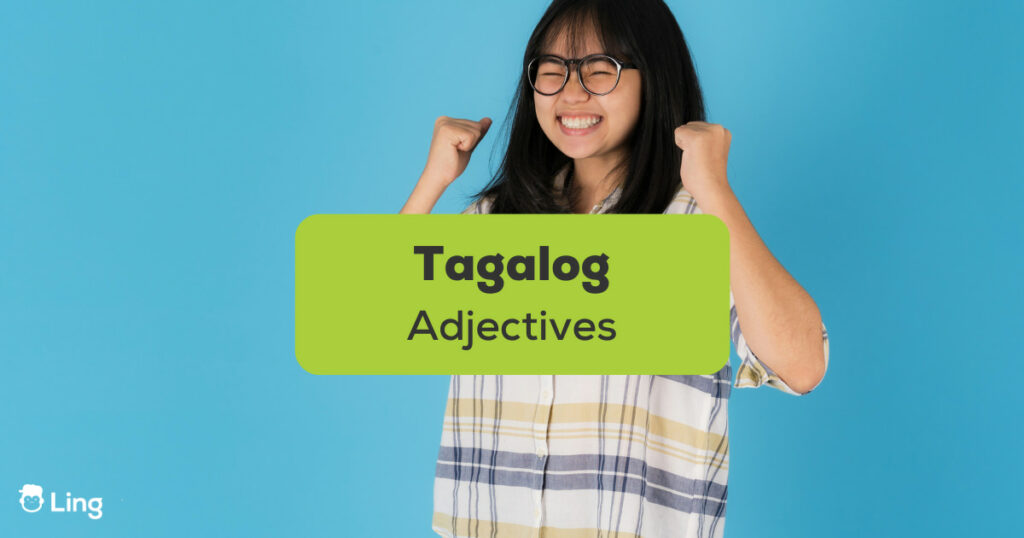Wondering how pang-uri or Tagalog adjectives work as compared to their English counterparts? In today’s content, we will walk you through the critical points to remember about this grammatical lesson and walk you through the most commonly used adjectives to describe people, places, and things.
We believe that it is essential for you to master Tagalog since adjectives are one of the first words you’ll ever have to learn when learning a totally new language. To help you get started on how the adjectives work in Tagalog grammar, continue reading below.
What Is The Structure Of Tagalog Adjectives?
Tagalog adjectives or pang-uri in Tagalog can take many forms, and this is something that you have to get used to. At times, it can be used to describe nouns and pronouns, but you can use it as an adverb or as a replacement for a noun or predicate. Take the case of the example sentences below:
- Matitipid and mga Caviteño. (The Caviteños are thrifty.)
- Mabuti na bata si Pihu. (Pihu is a good kid.)
- Ang masama ay hindi magtatagumpay. (The bad will not succeed.)
- Mabagal na naglakad and making kaibigan. (My friend walked slowly.)
Different Forms Of Adjectives In Tagalog
There are four adjective forms to follow, and this includes the simple (payak), affixed (maylapi), repeating (inuulit), and compound (tambalan). Thankfully, differentiating the four is pretty easy!
By the way, instead of using plain old materials for learning the Tagalog language, you can widen your vocabulary and learn about critical grammar points just by using free language learning applications like the Ling app. Ready to take it on for a spin? Download from the Play Store and the App Store today!
With that out of the way, let’s continue with the examples below:
Degree Of Comparison In Filipino Adjectives
Tagalog grammar is heavily based on English adjectives, which is why you can also expect three degrees of comparison here: positive (lantay), comparative (pahambing), and superlative (pasukdol).
The comparative degree also has two major types known as similar (magkatulad) and dissimilar (di-magkatulad), which compare two nouns or pronouns. If the comparative form is dissimilar, you may use palamang (to show supremacy over the other thing compared to) or pasahol (to show a lack of supremacy).
Below is an example of how it works:
| Lantay | Magkatulad | Pahambing Na Palamang | Pahambing Na Pasahol | Pasukdol |
|---|---|---|---|---|
| Maganda (beautiful) | Kasing-ganda (as beautiful as) | Mas maganda (more beautiful) | Di-masyadong maganda (not that beautiful) | Pinakamaganda (most beautiful) |
| Mataba (fat) | Magkasing-taba (as fat as) | Mas mataba (fatter) | Di-gaano mataba (not that fat) | Sobrang taba (very fat) |
| Mabango (fragrant) | magkasing-bango (as fragrant as) | Higit na mabango (more fragrant) | Di-gaano mabango (not that fragrant) | Saksakan ng bango (most fragrant) |

3 Tips To Remember About Tagalog Adjectives
Learning Tagalog languages is not as easy as it looks. However, it is not entirely impossible not to master it on your own. Here are a few tips that can help you remember the Tagalog adjectives.
Tip #1: Remember That The Basic Tagalog Word Form For Adjectives Uses “Ma” As Prefix
Many Tagalog adjectives start with the prefix Ma. This is a simple rule to remember. For example, malinis means “clean,” showing how Ma changes a word into an adjective.
| English | Prefix | Root Word | Result | Sound |
|---|---|---|---|---|
| noisy | ma | ingay | maingay | |
| wide | ma | lawak | malawak | |
| sweet | ma | tamis | matamis | |
| long | ma | haba | mahaba | |
| deep | ma | lalim | malalim | |
| clean | ma | linis | malinis |
Tip #2: Tagalog Adjectives Have Separate Singular And Plural Forms
Adjectives in Tagalog change depending on whether you’re talking about one thing or many. Knowing this helps you speak correctly. For instance, mabigat (heavy) becomes mabibigat when referring to several heavy items.
| English | Singular | Plural | Sound |
|---|---|---|---|
| heavy | mabigat | mabibigat | |
| colorful | makulay | makukulay | |
| delicious | masarap | masasarap | |
| strong | malakas | malalakas | |
| small | maliit | maliliit |
Tip #3: Tagalog Adjectives Can Differ Based On The Number Of What Is Being Described
In Tagalog, adjectives change based on how many things you describe. This helps make your sentences precise. For example, magaling (good) changes to magkakasing-galing when describing a group’s skill level.
| One | Two | Many |
|---|---|---|
| Kapatid ko siya. (He is my sibling.) | Magkapatid kami. (We are siblings.) | Magkakapatid kaming tatlo. (The three os us are siblings.) |
| Kasintahan ko siya. (She is my partner.) | Magkasintahan kami. (We are partners.) | Sila ay magkakasintahan (They are partners.) |
| Magaling siya (he is good) | kapwa magaling (both of them are good) | Magkakasing-galing sila (all of them are good) |
Examples Of Commonly Used Tagalog Adjectives
Interested to learn more about the most common adjectives used by Filipinos? We have compiled here and listed below all the commonly used words that you can try out when describing or modifying a statement. Most of these can be used for all the forms that we have discussed early on, so be sure to review the explanations above before using them.
What Are The Nine Major Parts Of The Tagalog Speech?
Same as in English, there are also nine major parts of speech in the Tagalog grammar, including nouns (pangalan), Tagalog verbs (pandiwa), adverbs (pang-abay), pronouns (panghalip), prepositions (pang-ukol), conjunctions (pangatnig), particles (ingklitik), adjectives (pang-uri), and ligatures (pang-angkop).
If you are just starting to master this, we highly recommend that you start by mastering Tagalog adjectives in order to express your thoughts and describe an object or a feeling.
This is particularly important, too, if you want to give compliments. You can use adjectives to modify or describe a quality, like the examples below:
- Siya ay maganda at matangkad! (She is beautiful and tall!)
- Matalinong bata si Mario! (Mario is an intelligent kid!)
- Mabilis tumakbo si Beng! (Beng runs fast!)

Wrapping Up: Tagalog Adjectives
So, we’ve learned many things about Tagalog adjectives. They are really important for talking or even writing in Tagalog. These words make your sentences more interesting, helping you describe people and places better. And here’s the thing: the more you practice, the easier it becomes.
Tagalog is a fun and expressive language. Mastering these Tagalog adjectives is a big step towards speaking it well. Just keep practicing, step by step, and you’ll find yourself getting better every day!
Updated By: Jefbeck









































